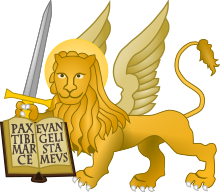
The winged lion is a mythological creature that resembles a lion with bird-like wings.

The winged lion is a mythological creature that resembles a lion with bird-like wings.
The winged lion is found in various forms especially in ancient and medieval civilizations.
There were different mythological adaptions for the winged lion:

The emblems of the winged lions were featured in different countries:
![]() Media related to Winged lions at Wikimedia Commons
Media related to Winged lions at Wikimedia Commons